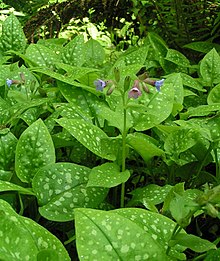Pulmonaria
| Pulmonaria | |
|---|---|
 |
|
| Pulmonaria officinalis | |
| Scientific classification | |
| Kingdom: | Plantae |
| Clade: | Angiosperms |
| Clade: | Eudicots |
| Clade: | Asterids |
| Order: | Boraginales |
| Family: | Boraginaceae |
| Subfamily: | Boraginoideae |
| Genus: |
Pulmonaria L., 1753 |
| Type species | |
|
Pulmonaria officinalis L., 1753 |
|
| Species | |
|
Pulmonaria affinis |
|
Pulmonaria affinis
Pulmonaria angustifolia
Pulmonaria filarszkyana
Pulmonaria kerneri
Pulmonaria longifolia
Pulmonaria mollis
Pulmonaria mollissima
Pulmonaria montana
Pulmonaria obscura
Pulmonaria officinalis
Pulmonaria rubra
Pulmonaria saccharata
Pulmonaria stiriaca
Pulmonaria vallarsae
Pulmonaria visianii
Pulmonaria (lungwort) is a genus of flowering plants in the family Boraginaceae, native to Europe and western Asia, with one species (P. mollissima) east to central Asia. According to various estimates there may be between 10 and 18 species found in the wild, but the taxonomy of this genus is very confusing.
The scientific name Pulmonaria is derived from Latin pulmo (lung). In the times of sympathetic magic, the spotted oval leaves of P. officinalis were thought to symbolize diseased, ulcerated lungs, and so were used to treat pulmonary infections. The common name in many languages also refers to lungs, as in English "lungwort" and German Lungenkraut. In some East European languages, the common name is derived from a word for honey, e.g. Russian medunitza and Polish miodunka.
Lungworts are evergreen or herbaceousperennials that form clumps or rosettes. They are covered in hairs of varied length and stiffness, and sometimes also bear glands. The underground parts consist of a slowly creeping rhizome with adventitious roots. Flowering stems are unbranched, rough, covered with bristly hairs, usually not exceeding 30 cm (12 in), with a few exceptions (P. mollis, P. vallarsae). The stems are usually upright, or slightly spreading.
...
Wikipedia
